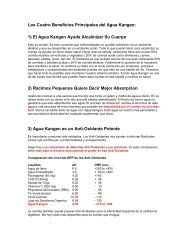ACID-ALKALINE BALANCE: ROLE IN CHRONIC ... - My Kangen Tools
ACID-ALKALINE BALANCE: ROLE IN CHRONIC ... - My Kangen Tools
ACID-ALKALINE BALANCE: ROLE IN CHRONIC ... - My Kangen Tools
Create successful ePaper yourself
Turn your PDF publications into a flip-book with our unique Google optimized e-Paper software.
calcium level generally contained in AIW (about 50ppm) and the value<br />
of pH, and that frequency of detecting some anaerobic bacteria tends<br />
to be higher in alkaline ionized water groups than the other, although<br />
the bacteria count in the intestine does not have significant difference.<br />
Based on these results, we made a judgment that effect of taking AIW<br />
supports part of inhibition mechanism against abnormal intestinal<br />
fermentation, which is one of the claims of efficacy that have been<br />
attributed to alkaline ionized water electrolyzers.<br />
*4 On the other hand, under the dietary condition of low intestinal<br />
fermentation, AIW uptake does not seem to inhibit fermentation that<br />
leads us to believe that effect of AIW uptake is characteristic of hyperfermentation<br />
state. Metabolites produced by intestinal fermentation<br />
include indole and skatole in addition to organic acids such as shortchain<br />
fatty acid and lactic acid as well as toxic metabolites such as<br />
ammonium, phenol and pcresol. We do not know how AIW uptake<br />
would affect the production of these materials. In this experiment, we<br />
have tested on ammonium production as explained in the following<br />
sections.<br />
Testing methods<br />
Four-week-old male Wistar/ST Clean rats were purchased from Japan<br />
SLC Co., Ltd. and were divided into 3 groups of 8 each after<br />
preliminary breeding. AIW of pH 9 and 10 was produced by an<br />
electrolyzer Mineone ROYAL NDX3 1 OH by Omco Co., Ltd. This model<br />
produces AIW by electrolyzing water with calcium lactate added. On<br />
the last day of testing, the rats were dissected under Nembutal<br />
anesthesia to take blood from the heart by a heparin-treated syringe.<br />
As to their organs, the small intestines, cecum and colon plus rectum<br />
were taken out from each of them. The cecurn was weighed and<br />
cleaned with physiological saline after its contents were removed, and<br />
the tissue weight was measured after wiping out moisture. Part of<br />
cecal contents was measured its pH, and the rest was used to assay<br />
ammonium concentration. The amount of ammonium contained in<br />
fresh feces and cecal contents was measured by the Nessler method<br />
after collecting it in the extracted samples using Conway's microdiffusion<br />
container. Fecal free-glucose was assayed by the oxygen<br />
method after extraction by hot water. Analysis of free amino acids<br />
contained in cecal contents was conducted by the Waters PicoTag<br />
amino acid analysis system.<br />
Test results and analyses<br />
No difference was found in the rats' weight gain, water and feed intake<br />
and feeding efficiency, nor was any particular distinction in appearance<br />
identified. The length of the small intestines and colon plus rectum<br />
tended to decline in AIW groups. PH value of cecal contents was higher<br />
and the amount of fecal free-glucose tended to be lower in AIW groups<br />
than the control group. Since there was no difference in fecal<br />
discharge itself, the amount of free-glucose discharged per day was at<br />
a low level. The amount of discharged free-glucose in feces is greater<br />
when intestinal fermentation is more intensive, which indicates that



